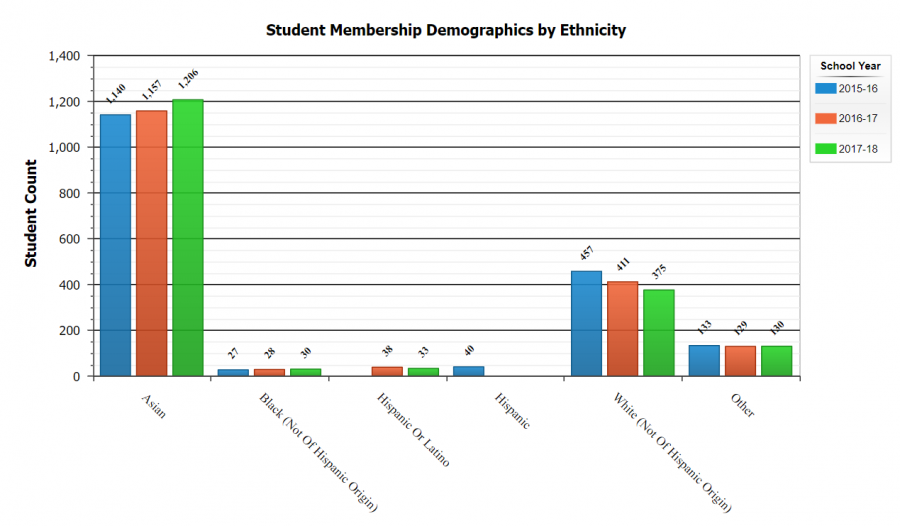Dwindling diversity
Jefferson’s ethnic ratios are falling behind the rest of the world
Photo Courtesy of FCPS School profiles and demographics site
The Asian student body is overwhelming compared to that of the African American, Hispanic, and Caucasian population at Jefferson.
November 25, 2018
Diversity at TJ is most often defined by the overwhelming Asian population. As of the 2017-2018 school year, Asians make up a towering 67.98% majority of Jefferson’s students. Obtained from the FCPS school profiles and demographics site, this one statistic begs the question, is diversity even prominent in the Jefferson community?
Thomas Jefferson High School for Science and Technology was designed to be an encompassing learning environment for students who wished to further their knowledge in STEM fields and be supported in their STEM endeavors by peers and teachers alike. Founded in 1985, Jefferson received $4 million worth of lab equipment from companies in order to jump start the laboratories that Jefferson is well known for.
Within the next few years, Caucasian and Asian students made up 90% of the school population. In the early 90’s, an enrichment program called Visions was started by the school board to expose minorities to Jefferson’s advanced program and namely, to diversify the ethnic ratios. Thereafter, in 1997, Jefferson’s diversity truly peaked as the number of African Americans and Latino students hit 9.4% of the school population. Due to Supreme Court decisions surrounding affirmative-action policies, board members voted to get rid of Visions in 1997, and from there, it went downhill..
In 2012, a complaint was filed with the U.S. Department of Education’s Office for Civil Rights by an activist group, stating that the admissions process at Jefferson discriminates against African American, Hispanic, and economically disadvantaged students. The complaint has yet to be resolved. Within the class of 2019, the acceptance rate for Asian students was 24% compared to the acceptance rate of black students, which was 4%. The acceptance rate for low-income students was even lower, at 3%.
When it comes to ethnicity statistics, it becomes blatant that there is no such concept of diversity at Jefferson. As stated before, Asians make up close to 68% of the student body, followed by Caucasians making it 21%. Hispanics or Latinos and African American students are both at 2%, and those classified as ‘other’ are at 7%. Again, obtained from the FCPS school profiles and demographics site , when these ratios are compared to Centreville High School, another high school in Fairfax county, the numbers seem even more compromised. At Centreville, Asians make up 33%, white students at 35%, Hispanics or Latinos at 19% and black students at 9%.
Families have been known to move to one of the six Northern Virginia school districts to make sure their children get a chance to attend Jefferson. Many move to the Herndon or McLean area, where respectively, Rachel Carson Middle School and Longfellow Middle School are located, as both schools retain a legacy of admitting the highest number of student to Jefferson. However, what then happens to the minorities, or the economically disadvantaged populations who have been living in one of the six districts their entire lives, but simply have never been exposed to the idea of STEM?
Many elementary schools in Fairfax County, enforce STEAM as opposed to STEM, right next to physical education, art, and music. STEAM, standing for science, technology, engineering, art, and mathematics, has been used as a way to expose all kids to the ever-growing influence that science and technology has on our world. This program encourages children to work on projects that incorporate STEAM elements, such as Hour of Code, or building efficient catapults. By implementing this program in all elementary and possibly even middle schools, we can truly hope to begin to diversify the so-called diversity at Jefferson.
Our rapidly changing world is becoming diverse in every way possible. Women have began to take part of STEM fields and politics. The last US President was African American, and ethnic representation is starting to show up in Hollywood. Through all this, Jefferson is the one that’s falling behind. We fail to support the various cultures that can only enlighten us with what the community has to offer. Yes, we go to a school for science and technology, but that in no way should that dictate the racial profiles of our school.






